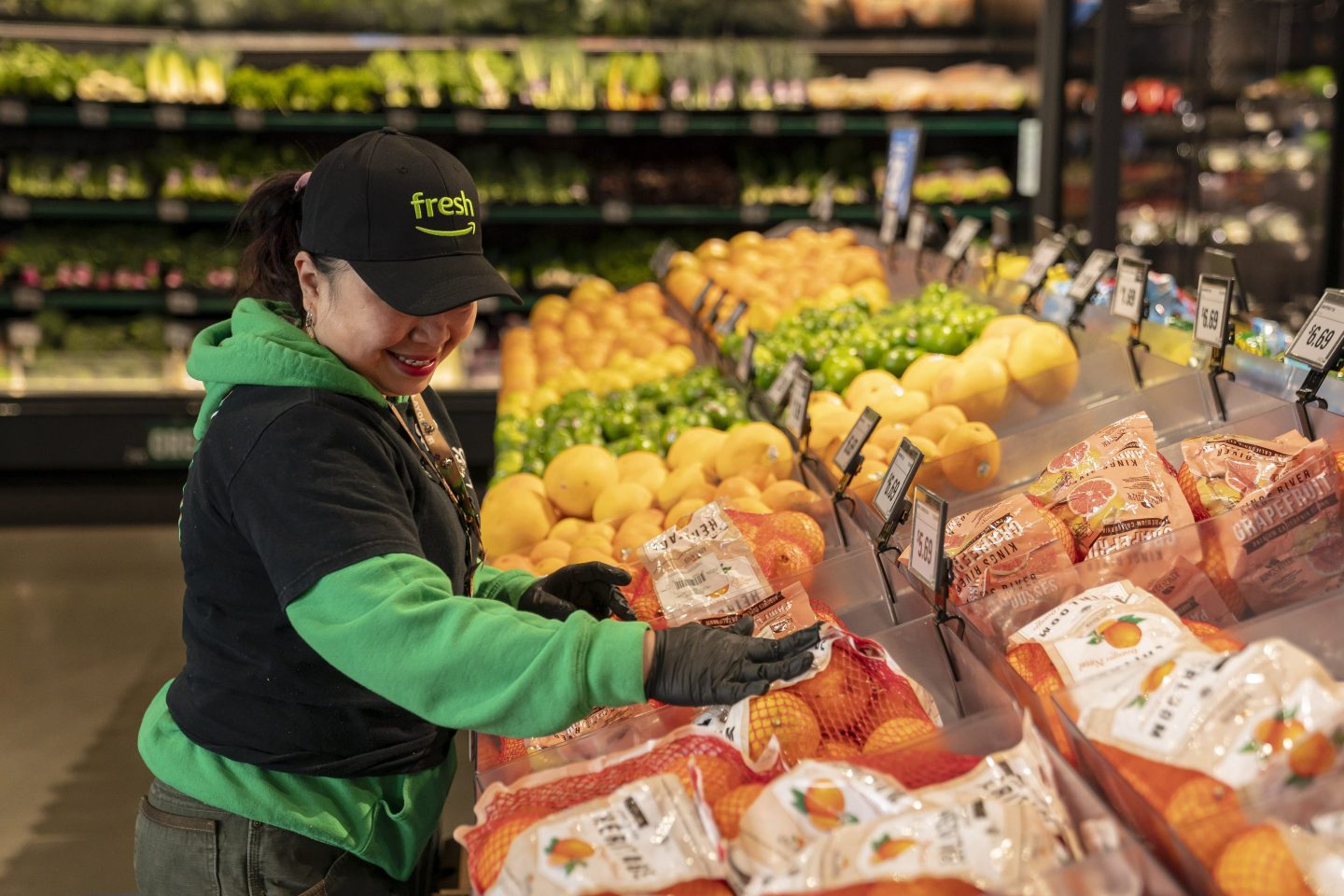
紧随沃尔玛(Walmart)和塔吉特(Target)的脚步,亚马逊生鲜(Amazon Fresh)刚刚成为最新一家削减数千种商品成本的大型零售商,扭转了多年来因通货膨胀导致的价格上涨趋势,以吸引心怀不满的顾客回流。
亚马逊旗下的子公司亚马逊生鲜周四宣布,将把每周轮换的4000种食品杂货的成本削减至多30%。折扣将适用于国内品牌和亚马逊自营品牌。
亚马逊生鲜全球副总裁克莱尔·彼得斯在一份声明中表示:“无论是在实体店还是在网上,增加数千种商品的每周优惠,扩大Prime会员优惠在亚马逊生鲜的覆盖范围,这只是我们继续投资于具有竞争力的价格和为所有顾客提供优惠的一种方式。”
上周,许多零售商纷纷推出必需品折扣:塔吉特做出了与亚马逊类似的承诺,称将下调包括尿布和宠物食品在内的5000种商品的价格。今年2月,这家零售商推出了“dealworthy”折扣品牌,包括400种家庭用品和必需品,其中大部分商品的价格不到10美元。沃尔玛还表示,将降低7000种商品的成本,价格回调幅度达45%。阿尔迪(Aldi)和克罗格(Kroger)也都采取了降低食品杂货价格的措施。
在此之前,截至4月份,持续的通货膨胀使食品杂货成本同比上涨了1.1%。这一数字较3月份下降了0.1%,远低于餐厅食品价格4.1%的同比涨幅,这让零售商有机会利用消费者对食品杂货日益依赖的机会。
沃尔玛首席执行官董明伦本月对分析师表示:“一如既往,我们将在价格上领先,并控制利润率。”
零售商感受到压力
大型零售商降价并不是在艰难时期向顾客抛出橄榄枝的利他之举。由于消费者难以忍受高昂的价格,零售商的销售疲软。塔吉特公布净销售额较上年同期下降3.1%,季度可比销售额下降3.7%,连续第四个季度出现下滑。尽管沃尔玛的业绩持续飙升,但其6%的收入增长主要归功于其在电子商务领域的成功和富裕的客户群,后者在其受众中所占的比例越来越大。
这一趋势在快餐业也得到了延续,麦当劳(McDonald’s)、温迪汉堡(Wendy’s)和汉堡王(Burger King)都宣布推出餐食优惠。此前的收益报告显示,消费者正在失去对高价快餐的兴趣,包括18美元的巨无霸套餐和价格飙升的威胁。
此外,经济政策组织Groundwork Collaborative的执行董事林赛·欧文斯认为,零售商最初提价的决定不能完全归咎于通货膨胀。她对《华盛顿邮报》表示,在运营成本增加的同时,企业的利润率实际上也在增加。美国联邦贸易委员会(Federal Trade Commission)2024年3月的一份报告发现,2023年前三季度,食品和饮料的零售收入比总成本增长了7%,这表明杂货店提价的决定不仅仅是通货膨胀、供应链中断或大宗商品价格上涨的结果。
欧文斯说:“你所看到的是,这些公司实际上是通过将上涨的成本全部转嫁给了消费者,然后再争取更多的利润来实现这一目标的。”(财富中文网)
译者:中慧言-王芳
紧随沃尔玛(Walmart)和塔吉特(Target)的脚步,亚马逊生鲜(Amazon Fresh)刚刚成为最新一家削减数千种商品成本的大型零售商,扭转了多年来因通货膨胀导致的价格上涨趋势,以吸引心怀不满的顾客回流。
亚马逊旗下的子公司亚马逊生鲜周四宣布,将把每周轮换的4000种食品杂货的成本削减至多30%。折扣将适用于国内品牌和亚马逊自营品牌。
亚马逊生鲜全球副总裁克莱尔·彼得斯在一份声明中表示:“无论是在实体店还是在网上,增加数千种商品的每周优惠,扩大Prime会员优惠在亚马逊生鲜的覆盖范围,这只是我们继续投资于具有竞争力的价格和为所有顾客提供优惠的一种方式。”
上周,许多零售商纷纷推出必需品折扣:塔吉特做出了与亚马逊类似的承诺,称将下调包括尿布和宠物食品在内的5000种商品的价格。今年2月,这家零售商推出了“dealworthy”折扣品牌,包括400种家庭用品和必需品,其中大部分商品的价格不到10美元。沃尔玛还表示,将降低7000种商品的成本,价格回调幅度达45%。阿尔迪(Aldi)和克罗格(Kroger)也都采取了降低食品杂货价格的措施。
在此之前,截至4月份,持续的通货膨胀使食品杂货成本同比上涨了1.1%。这一数字较3月份下降了0.1%,远低于餐厅食品价格4.1%的同比涨幅,这让零售商有机会利用消费者对食品杂货日益依赖的机会。
沃尔玛首席执行官董明伦本月对分析师表示:“一如既往,我们将在价格上领先,并控制利润率。”
零售商感受到压力
大型零售商降价并不是在艰难时期向顾客抛出橄榄枝的利他之举。由于消费者难以忍受高昂的价格,零售商的销售疲软。塔吉特公布净销售额较上年同期下降3.1%,季度可比销售额下降3.7%,连续第四个季度出现下滑。尽管沃尔玛的业绩持续飙升,但其6%的收入增长主要归功于其在电子商务领域的成功和富裕的客户群,后者在其受众中所占的比例越来越大。
这一趋势在快餐业也得到了延续,麦当劳(McDonald’s)、温迪汉堡(Wendy’s)和汉堡王(Burger King)都宣布推出餐食优惠。此前的收益报告显示,消费者正在失去对高价快餐的兴趣,包括18美元的巨无霸套餐和价格飙升的威胁。
此外,经济政策组织Groundwork Collaborative的执行董事林赛·欧文斯认为,零售商最初提价的决定不能完全归咎于通货膨胀。她对《华盛顿邮报》表示,在运营成本增加的同时,企业的利润率实际上也在增加。美国联邦贸易委员会(Federal Trade Commission)2024年3月的一份报告发现,2023年前三季度,食品和饮料的零售收入比总成本增长了7%,这表明杂货店提价的决定不仅仅是通货膨胀、供应链中断或大宗商品价格上涨的结果。
欧文斯说:“你所看到的是,这些公司实际上是通过将上涨的成本全部转嫁给了消费者,然后再争取更多的利润来实现这一目标的。”(财富中文网)
译者:中慧言-王芳
Amazon Fresh just became the latest big-box retailer to cut costs on thousands of items, following in the footsteps of Walmart and Target in reversing course on years of inflation-induced price hikes in a bid to lure back disgruntled customers.
The company’s Amazon Fresh subsidiary announced Thursday it will slash the costs of 4,000 weekly rotating grocery products by up to 30%. The discounts will apply to both national and Amazon’s store brands.
“Increasing our Weekly Deals across thousands of items and expanding the reach of Prime Savings at Amazon Fresh is just one way that we’re continuing to invest in competitive pricing and savings for all of our customers—both in-store and online,” Amazon Fresh worldwide vice president Claire Peters said in a statement.
Last week saw an onslaught of retailers offering discounts on essential items: Target made a similar promise as Amazon’s, saying it would cut the prices of 5,000 items including diapers and pet food. The retailer rolled out its “dealworthy” discount brand in February, introducing 400 household and essential products mostly under $10. Walmart also said it would lower costs of 7,000 items, a 45% increase in price rollbacks. Aldi and Kroger both made moves to lower grocery prices as well.
These price cuts come after persistent inflation raised the cost of groceries 1.1% year over year as of April. That’s down 0.1% from March and significantly less than the 4.1% year-over-year price increase for food from restaurants, leaving retailers with an opportunity to take advantage on consumers’ increased reliance on groceries.
“We’re going to lead on price, and we’re going to manage our [profit] margins, and we’re going to be the Walmart that we’ve always been,” Walmart CEO Doug McMillon told analysts this month.
Retailers feel the pressure
Big-box stores lowering prices wasn’t an altruistic move to throw customers a bone during tough times. Retailers have suffered from weak sales due to customers’ struggle with high prices. Target reported a 3.1% drop in net sales from a year ago and a 3.7% quarterly dip in comparable sales, marking its fourth consecutive quarter of declines. Though Walmart has continued to soar, it owes much of its 6% revenue growth to its e-commerce successes and wealthy customer base, the latter of which makes up a growing chunk of its audience.
This trend has continued in fast food, with McDonald’s, Wendy’s, and Burger King all announcing meal deals following earnings reports that suggest customers are losing their taste for high-priced fast food, including $18 Big Mac meals and threats of surge pricing.
Moreover, retailers’ decision to hike prices in the first place can’t all be attributed to inflation, Lindsay Owens, executive director of economic policy group Groundwork Collaborative, argued. She told the Washington Post that companies actually increased their margins in times of increased operating costs. A March 2024 Federal Trade Commission report found retail revenue for food and beverages increased 7% above total costs in the first three quarters of 2023, indicating that grocery stores’ decision to raise prices wasn’t just a result of inflation, supply-chain disruptions, or the rising prices of commodities.
“What you see is that’s effectively made possible by companies who are passing along their rising costs in full but then going for more,” Owens said.






